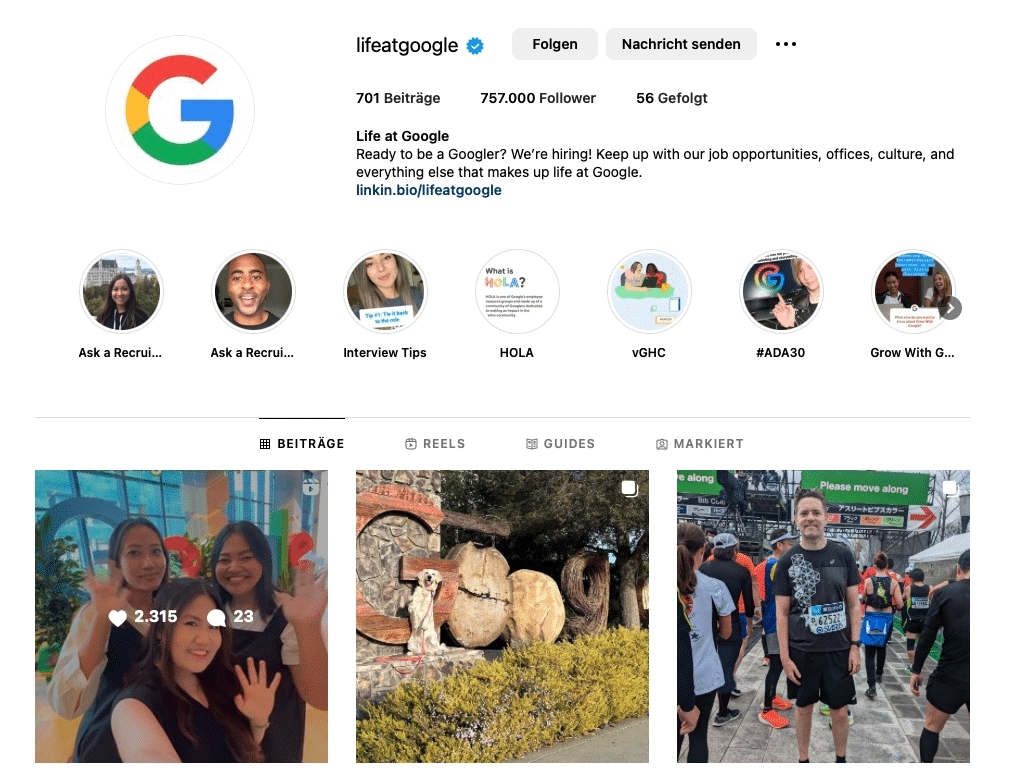10 Ways to Integrate Storytelling into Employer Branding
Everything is permitted in war and in love. We would not subscribe to this wisdom in the battle for new employees. The fact is, however, that the “war for talent” is becoming an ever greater challenge for companies. Attracting talented colleagues naturally requires an interesting job offer and an appropriate salary. But the best benefits are useless if the applicant doesn’t get the spark. This is where employer branding comes into play: this discipline is important for attracting and retaining talent, improving the company’s image and increasing employee motivation. Because only a strong employer brand helps companies to be successful in today’s competitive job market.
Ultimately, as with many important decisions in life, choosing a job is all about gut feeling. Storytelling is a perfect tool for appealing to the emotions of potential new team members.
We have explained here how storytelling can be woven into career pages, for example.
But how exactly can stories be used effectively to build a strong employer brand? In this post, we give 10 practical tips on how to use storytelling for employer branding.

Successful employer branding goes beyond telling people how great the company is. To create a strong bond between the brand and the target group, the people behind it must be integrated into the story. In the best case scenario, storytelling gives them the feeling that they are not just being sold something, but that they are part of an exciting adventure with the company.
Value Storytelling
Values are at the beginning of every successful storytelling. Each story should reflect the principles of the organization and what drives the people in the company. If you have not already done so, we recommend that you first identify the company’s most important values: What specifically is to be achieved with the work? Which business practices does everyone involved in the company use and which do they reject? What principles are important in daily cooperation and interpersonal interaction? The team can then jointly evaluate which values should form the basis of the stories.
Employees as Heroes
Employees become heroes and tell their own personal stories. Sufficient space should therefore be given so that employees can talk about their goals and why they are proud to be part of the team.
Employee stories are also a good way to illustrate that the company is more than just a job. This is only possible if the stories are authentic and relevant. To do this, it is important to first listen carefully to your colleagues as part of storylistening: What makes up their daily work? What motivates them? Challenges should also be asked about, because every good story also has hurdles that have to be overcome to reach a happy ending.
These stories give potential applicants an idea of what it is like to work in this company. It is also interesting for current employees to read the stories of their colleagues and find out more about them. This strengthens the sense of community. Further contributions can then show how employees are supported and encouraged with further training and other development opportunities.

Company History
Every company is shaped by the people who have accompanied its development. The history of the company therefore provides a perfect stage to illustrate the contribution of the people involved. For example, stories about growth and change and why this was only possible thanks to the input of committed team members are suitable for this. These development stories can then be illustrated with pictures, videos and text.
Vision and Mission
Every good organization has a higher goal. And this does not only refer to economic interests. For example, Airbnb not only wants to earn money by providing accommodation, but also by bringing tourists and hosts together all over the world. The vision and mission are therefore central elements of the corporate strategy. The vision describes the company’s long-term vision for the future, while the mission describes how the company intends to achieve its vision. They help to create a clear focus for the platform and increase employee motivation. Storytelling is perfect for communicating vision and mission. This method can be used to explain what drives the company and how it contributes to creating a better world.
Working Atmosphere on Site
Storytelling can also be used to vividly present the working environment. For example, by showing how the company creates a positive culture and how employees interact with each other. To this end, it makes sense to regularly accompany various team members in their day-to-day work. Whether in a stylish office, co-working space or in the comfort of your own home, you can clearly see the different places where people work creatively and productively.
It becomes particularly interesting when colleagues from abroad are also allowed to work as part of Workation. After all, which applicant wouldn’t like a picture of the “office” on the beach?
Find out how our senior consultant Christina became a pioneer for Workation here: Christina’s Mashie story

Customers as Mentors
Interested applicants now know what drives the company and the people who work there. But what about the customers? After all, the relationship with them plays a major role in their later working life. It is therefore also a good idea to tell their stories and how the company has helped them. In this way, clients could share their experiences with the company and show how the company has enriched their lives in the form of credible stories. For example, a video on the website or an article as a blog post is suitable for this.
Only real people should be portrayed and in particular the interaction with employees should be emphasized. This gives potential applicants an authentic and, above all, concrete insight into the nature of the projects and the positive impact that working at this company has on others.
Team and Individual Profiles
To help applicants get to know their future colleagues better, we recommend setting up a separate section on the website to introduce the individual teams and people. This gives us the opportunity to gain an insight into their personalities and to present the employees with an approachable touch. After all, these are real people with a life outside of work, not just employees of the company.
High-quality and authentic photos and videos should always be used. In addition to pictures, name and job position, it is helpful to introduce the team members with a few short sentences. The colleagues describe themselves best: What makes them special? What skill makes them indispensable at work? What special hobby do you have? The more human the employer brand is presented, the better it will be received by applicants. In addition, social media can be used to post photos of team members and engage with them on platforms such as Instagram or LinkedIn – another fantastic way to humanize an otherwise impersonal company culture and increase engagement.
Videos and Animations
Videos and animations are perfect tools for telling stories. This is because visual content is often more effective than text in arousing emotions and establishing a connection with the audience. For example, videos can be used to tell the story of the company, its products and services. Above all, however, it can be used to portray employees and customers. The more different the people portrayed are, the better. For example, it can show how parents use flexible working hours to be there for their children or how a team member pursues an unusual hobby in their free time. Workations naturally offer a particularly appealing setting for videos with a beautiful natural backdrop.

Posts on Social Media
In addition to your own website, social networks offer a good opportunity to use storytelling for employer branding. Regularly sharing stories about life at the company on suitable social media channels such as Instagram, Facebook or LinkedIn can help to arouse the interest of potential applicants. Another advantage of social media is that you can get in direct contact with interested parties. Q&A sessions or a livestream of a team event, for example, are suitable for this.
A successful example of storytelling to attract new colleagues is the Instagram page “Life at Google”, which celebrates everyday life at the tech company’s various locations. Interested parties are inspired and provided with information on areas of work, career opportunities and benefits. This arouses interest and builds a strong employer brand. The content is authentic and entertaining and offers real added value for visitors.

Blogposts
A well-maintained blog section on the website is also the perfect place to tell longer stories. It provides the digital home for everything that happens in the company. In the best case scenario, interested parties can easily access the blog if they are looking at the website because of a job advertisement, for example. This gives them an immediate impression of the atmosphere in the company and whether it really suits them. This can be a decisive advantage in ensuring that viewers actually apply. It also provides an opportunity to bring remote team members up to date, especially in times of remote work.
In the blog, for example, you can write about how the company was founded or what it means to be part of the team. The articles are also a good place for stories about individual customers or employees. In addition, short social media posts can be used perfectly to tease a blog post and link to it.
Finding and Retaining Talented Employees with Good Stories
Good and above all authentic employer branding is more than just telling people how great the organization is. In order to create a strong bond between the brand and the target group, employees must firstly become part of the narrative and secondly be given the feeling that their work is meaningful. To do this, their stories must be told in an appealing way and suitable narratives must be used in a targeted manner.
In summary, incorporating storytelling into employer branding is an easy way for companies to connect with potential and current employees on an emotional level. With our 10 tips, we provide concrete ideas on how this can be implemented.
By the way: In our blog post on female employer branding, we have summarized for you how you can specifically address female talent in recruiting.
Share this article








